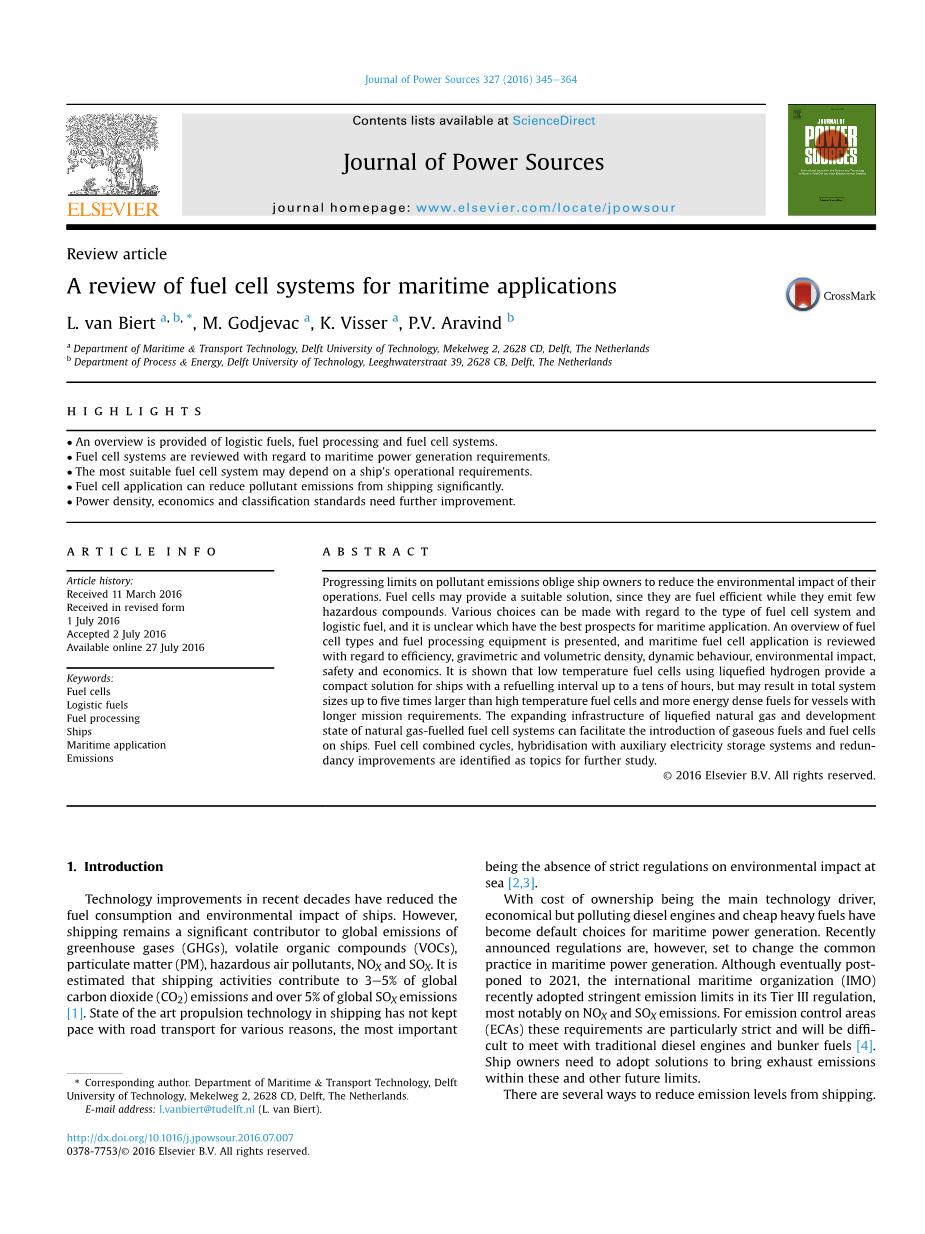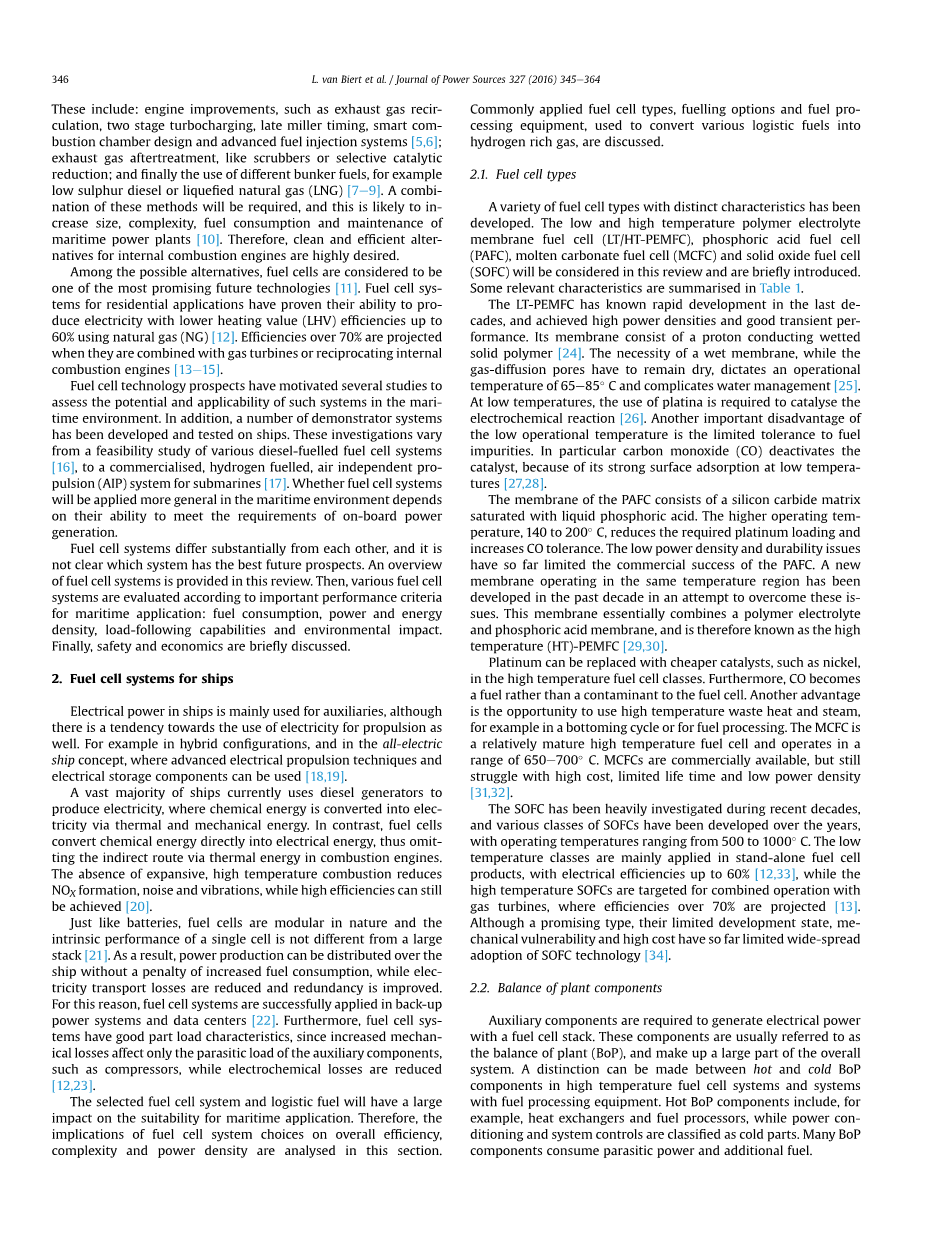

英语原文共 20 页,剩余内容已隐藏,支付完成后下载完整资料
|
Journal of Power Sources Journal homepage: www.elsevier.com/locate/jpowsour |
电源杂志 杂志主页: www.elsevier.com/locate/jpowsour |
|||||||
|
A review of fuel cell systems for maritime applications L. van Biert,M. Godjevac , K. Visser, P.V. Aravind |
船用燃料电池系统综述 范bull;贝尔特,戈杰瓦茨,韦瑟,阿拉文德 |
|||||||
|
a:Department of Maritime amp; Transport Technology, Delft University of Technology, Mekelweg 2, 2628 CD, Delft, The Netherlands b: Department of Process amp; Energy, Delft University of Technology, Leeghwaterstraat 39, 2628 CB, Delft, The Netherlands |
1:荷兰代尔夫特技术大学海事与运输技术系,Mekelweg 2,2628 CD。 2:荷兰代尔夫特技术大学工艺与能源系,Leeghwaterstraat 39,2628 CB。 |
|||||||
|
Highlight An overview is provided of logistic fuels, fuel processing and fuel cell systems. Fuel cell systems are reviewed with regard to maritime power generation requirements. The most suitable fuel cell system may depend on a ship#39;s operational requirements. Fuel cell application can reduce pollutant emissions from shipping significantly. Power density, economics and classification standards need further improvement. |
亮点 概述了后勤燃料、燃料加工和燃料电池系统。 对燃料电池系统进行了审查,以满足海上发电的要求。 最合适的燃料电池系统可能取决于船舶的操作要求。 应用燃料电池可以有效地降低船舶fi的污染物排放。 功率密度、经济性和fi阳离子标准有待进一步提高。 |
|||||||
|
Articleinfo Article history: Received 11 March 2016 Received in revised form 1 July 2016 Accepted 2 July 2016 Available online 27 July 2016 Keywords: Fuel cells Logistic fuels Fuel processing Ships Maritime application Emissions |
文章信息。 文章历史:该文章于2016年3月11日收录,经修订的表格1于2016年7月1日接收,2016年7月2日收录,2016年7月27日后可在线查阅。 关键词: 燃料电池 物流燃料 燃料加工 船舶 海上应用 排放 |
|||||||
|
Abstract Progressing limits onpollutantemissions oblige ship owners to reduce the environmental impact of their operations. Fuel cells may provide a suitable solution, since they are fuel efficient while they emit few hazardous compounds. Various choices can be made with regard to the type of fuel cell system and logistic fuel, and it is unclear which have the best prospects for maritime application. An overview of fuel cell types and fuel processing equipment is presented, and maritime fuel cell application is reviewed with regard to efficiency, gravimetric and volumetric density, dynamic behaviour, environmental impact, safety and economics. It is shown that low temperature fuel cells using liquefied hydrogen provide a compact solution for ships with a refuelling interval up to a tens of hours, but may result in total system sizes up to five times larger than high temperature fuel cellsand moreenergy dense fuels for vessels with longer mission requirements. The expanding infrastructure of liquefied natural gas and development state of natural gas-fuelled fuel cell systems can facilitate the introduction of gaseous fuels and fuel cells on ships. Fuel cell combined cycles, hybridisation with auxiliary electricity storage systems and redundancy improvements are identified as topics for further study. copy; 2016 Elsevier B.V. All rights reserved. |
摘要: 由于全球对污染物排放的逐步限制迫使船东减少其作业对环境的影响。因此燃料电池为人们提供了一个合适的解决方案,因为燃料电池燃料效率高,并且他们排放的危险化合物很少。当前燃料电池系统和后勤燃料的类型有很多选择,目前尚不清楚哪一种燃料电池系统和后勤燃料具有最好的海运应用前景。本文概述了燃料电池的类型和燃料处理设备,并从效率、重量和体积密度、动态特性、环境影响、安全和经济性等方面评述了海上燃料电池的应用。结果表明,使用液化氢的低温燃料电池为燃料间隔长达数十小时的船舶提供了一种严格的解决方案,但可使整个系统的大小达到高温燃料电池的5倍,并为具有较长航行任务要求的船舶提供更多的能源密集燃料。随着液化天然气基础设施的不断扩大和天然气燃料电池系统的发展,可以为船舶引入气体燃料和燃料电池提供便利。燃料电池联合循环、与辅助储能系统的混合以及改进被确定为进一步研究的课题。 2016年Elsevier B.V.版权所有。 |
|||||||
|
1. Introduction |
1.介绍 |
|||||||
|
Technology improvements in recent decades have reduced the fuel consumption and environmental impact of ships. However, shipping remains a significant contributor to global emissions of greenhouse gases (GHGs), volatile organic compounds (VOCs), particulate matter (PM) ,hazardous air pollutants,NOX and SOX.It is estimated that shipping activities contribute to 3—5% of global carbon dioxide (CO2) emissions and over 5% of global SOX emissions. State of the art propulsion technology in shipping has not kept pace with road transport for various reasons, the most important being the absence of strict regulations on environmental impact at sea . With cost of ownership being the main technology driver, economical but polluting diesel engines and cheap heavy fuel shave become default choices for maritime power generation. Recently announced regulations are, however, set to change the common practice in maritime power generation. Although eventually postponed to 2021, the international maritime organization (IMO) recently adopted stringent emission limits in its Tier III regulation, most notably on NOX and SOX emissions. For emission control areas (ECAs) these requirements are particularly strict and will be difficult to meet with traditional diesel engines and bunker fuels. Ship owners need to adopt solutions to bring exhaust emissions within these and other future limits. There are several ways to reduce emission levels from shipping. These include: engine improvements, such as exhaust gas recirculation, two stage turbocharging, late miller timing, smart combustion chamber design and advanced fuel injection systems ; exhaust gas aftertreatment, like scrubbers or selective catalytic reduction;and finally the use of different bunker fuels,for example low sulphur diesel or liquefied natural gas (LNG). A combination of these methods will be required, and this is likely to increase size, complexity, fuel consumption and maintenance of maritime power plants. Therefore, clea 全文共119792字,剩余内容已隐藏,支付完成后下载完整资料 资料编号:[2181] |
||||||||
以上是毕业论文外文翻译,课题毕业论文、任务书、文献综述、开题报告、程序设计、图纸设计等资料可联系客服协助查找。


